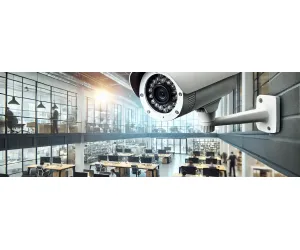
Why Intrusion Detection Systems Matter
Effective protection now requires more than just traditional locks or cameras—proactive detection is essential. Intrusion Detection Systems (IDS) offer early warning capabilities, helping you act before a security breach occurs.
Whether for a private home, office, warehouse, or commercial building, IDS devices serve as the first line of defense by detecting intrusions and triggering real-time alerts.
What is an Intrusion Detection System (IDS)?
An Intrusion Detection System is a security solution that uses sensors to monitor specific areas and identify signs of unauthorized access or suspicious activity. When an intrusion is detected, the system can:
-
Trigger a local siren
-
Notify you through a mobile app or monitoring center
-
Activate CCTV recording or lock-down systems
Modern IDS solutions are scalable, wireless, and often part of smart security platforms, making them suitable for homes, offices, and high-risk environments.
Types of Intrusion Detection Systems
1. Motion Detectors
-
Use PIR (passive infrared), microwave, or dual-tech sensors to detect movement.
-
Ideal for hallways, living rooms, and commercial interiors.
-
Often used in combination with smart lighting or alarm systems.
2. Door and Window Contact Sensors
-
Detect when doors or windows are opened unexpectedly.
-
Use magnetic contacts to trigger alerts when separated.
-
Common in homes, offices, and apartment entries.
3. Glass Break Sensors
-
Detect the frequency of breaking glass through acoustic sensors.
-
Provide coverage for large windows and glass storefronts.
-
Often used with contact sensors for layered protection.
4. Shock and Vibration Sensors
-
Respond to physical impact or tampering with doors, windows, or safes.
-
Ideal for vaults, ATM machines, or storage units.
-
Alert before actual entry occurs.
5. Infrared Beam Sensors (Active IR)
-
Emit invisible beams between two points—when interrupted, an alert is triggered.
-
Best for driveways, gates, and outdoor perimeter zones.
-
Reliable for long-distance detection.
6. Audio-Based Intrusion Detection
-
Uses microphones to detect breaking glass, forced entry, or movement in quiet zones.
-
Ideal for libraries, museums, banks, and data centers.
-
Works well in areas where noise is a red flag.
7. Microwave and Ultrasonic Sensors
-
Emit waves and detect changes in reflection due to movement.
-
Used in elevators, clean rooms, and high-security labs.
-
Provide 3D detection and high precision.
How to Choose the Right Intrusion Detection System
To select the most effective IDS setup for your property, consider:
-
Location size and layout: Small homes may need fewer devices; warehouses require wide-area coverage.
-
Security goals: Whether you're focused on burglary prevention, intrusion alerts, or silent monitoring.
-
Installation environment: Indoor vs. outdoor, presence of pets, or temperature variation.
-
Integration needs: Compatibility with smart home platforms, CCTV, and remote apps.
For full coverage, many modern systems use a hybrid approach, combining multiple sensor types across strategic entry points.
Advanced IDS Features in 2025
-
AI-enhanced filtering to reduce false alarms
-
Wireless and battery-powered sensor options
-
Cloud-based alert systems with remote access
-
Integration with smart locks, lighting, and cameras
-
Mobile app control with push notifications and status monitoring
Conclusion
An effective Intrusion Detection System adds a proactive layer of protection to any property. From homes to high-risk commercial spaces, IDS solutions help detect intrusions, trigger alerts, and enable faster response—before the damage is done.
To explore advanced, certified, and locally supported IDS solutions, visit BSTA.sa—Saudi Arabia’s trusted platform for integrated security systems.
Frequently Asked Questions (FAQs)
-
What is the difference between an intrusion detection system and an alarm system?
IDS detects suspicious activity; an alarm system responds with sirens or alerts. IDS is often a part of a larger alarm system. -
Can I install intrusion detection sensors myself?
Basic devices like door contacts can be DIY, but professional installation is recommended for complex systems like IR beams or perimeter detection. -
Are intrusion detection systems suitable for outdoor use?
Yes, especially models like infrared beams and shock sensors—ensure they are weatherproof and professionally installed. -
Which IDS is best for home security?
A combination of motion detectors, glass break sensors, and door/window contacts typically offers well-rounded home protection. -
How do glass break sensors work?
They use acoustic sensors to detect the unique sound frequency of shattering glass, then trigger an alert. -
What if the system triggers false alarms?
Most modern systems support calibration and AI filtering to minimize false alerts. Placement and maintenance are key. -
Do IDS devices work with smart home systems?
Many newer systems integrate with Alexa, Google Home, and smart apps, allowing remote control and automation. -
Do I need internet access for an IDS?
Local alerts work offline, but remote monitoring and app notifications require an internet connection. -
How much do IDS systems cost?
Prices range from SAR 500 for basic home setups to SAR 5,000+ for large commercial installations. -
Can I monitor the IDS remotely?
Yes. Most systems offer mobile apps or cloud-based dashboards for live monitoring and alerts.







